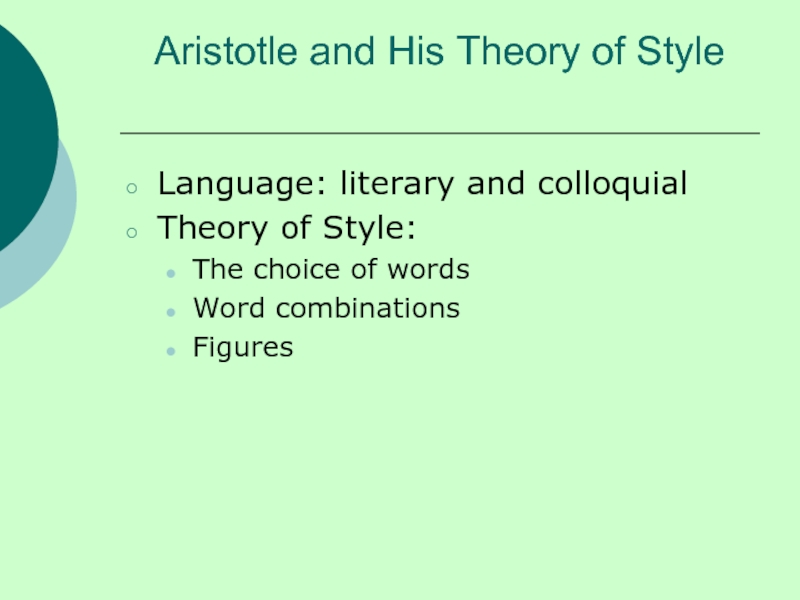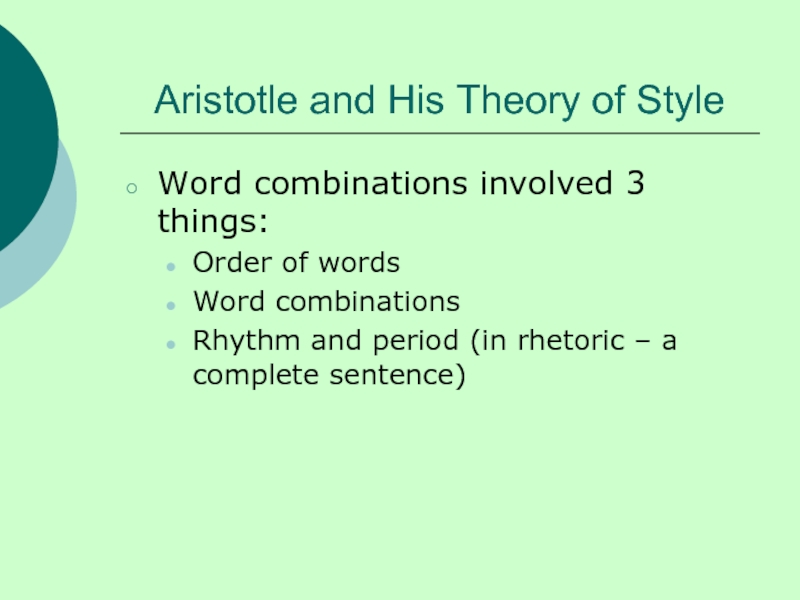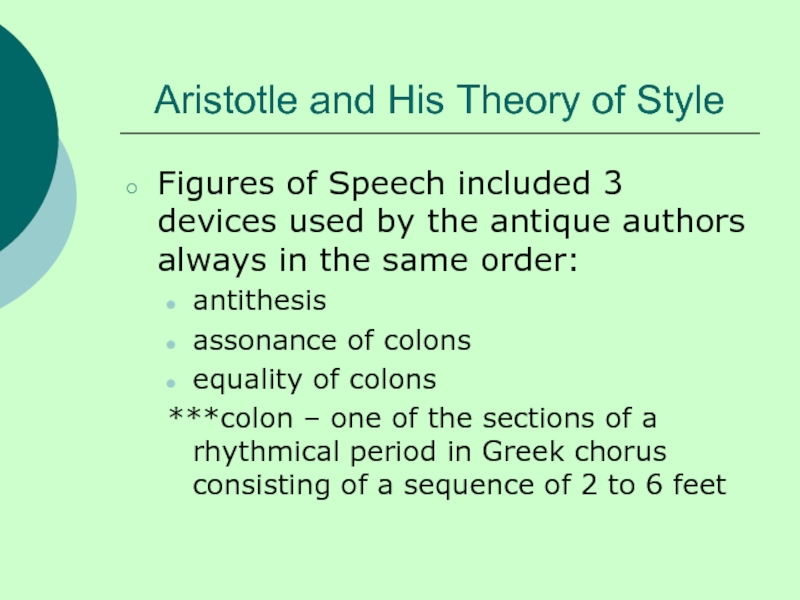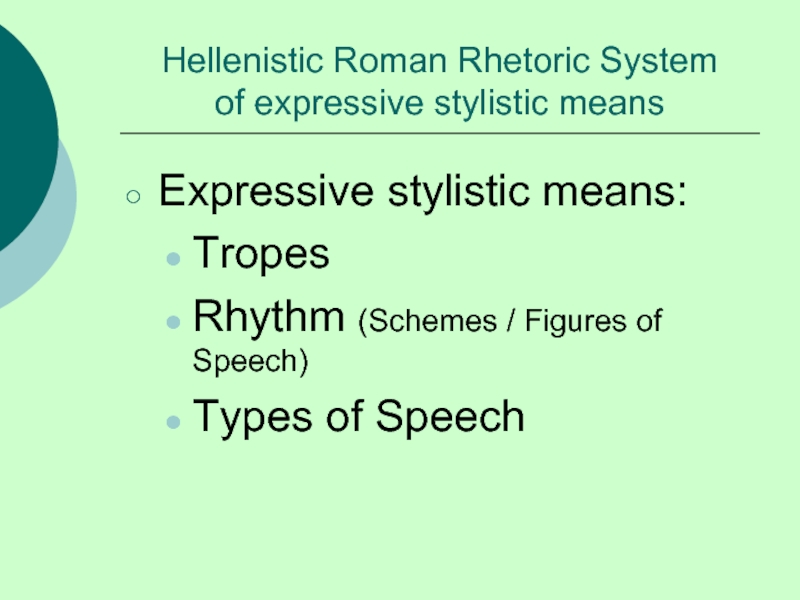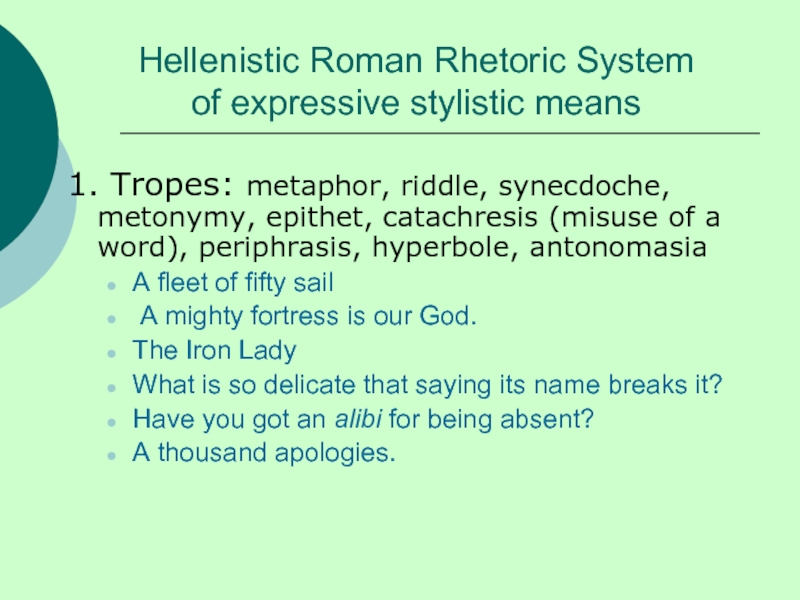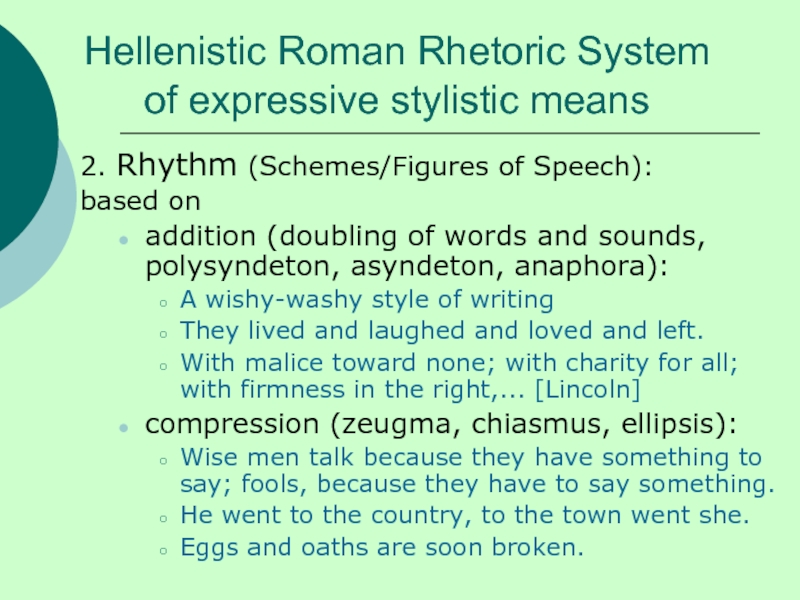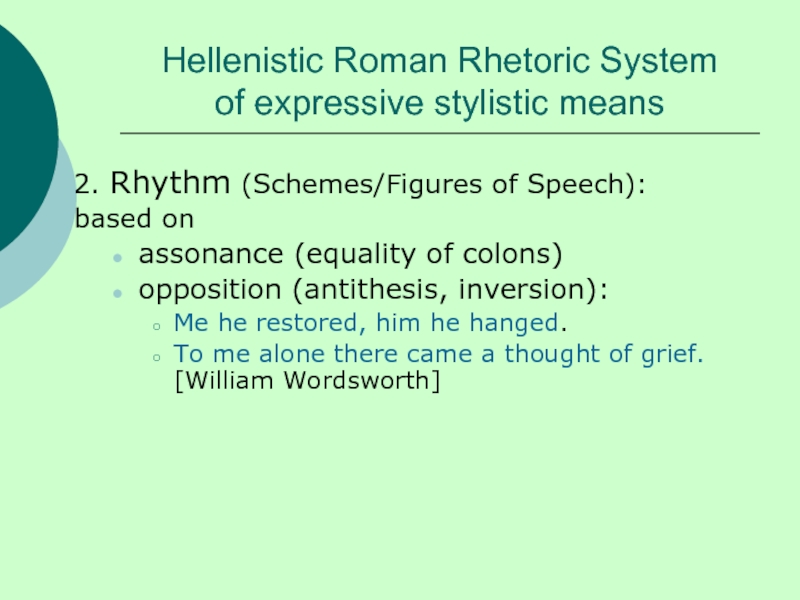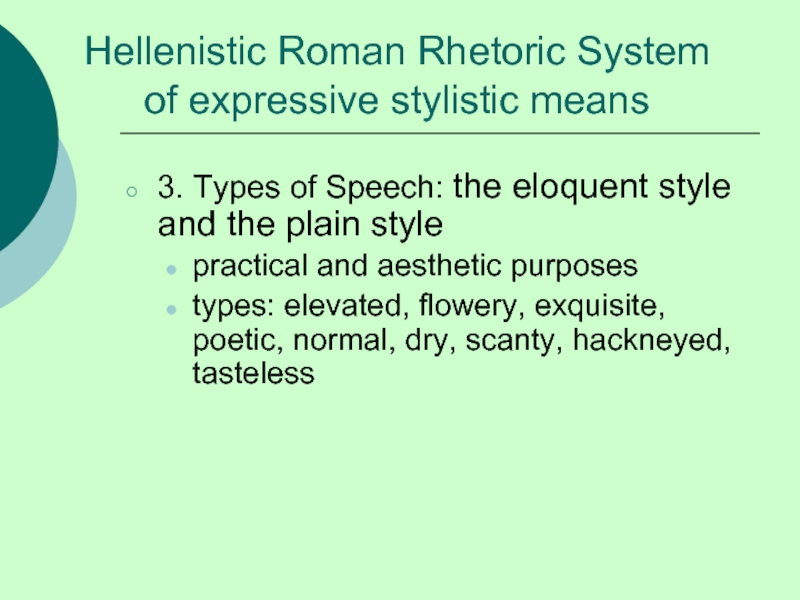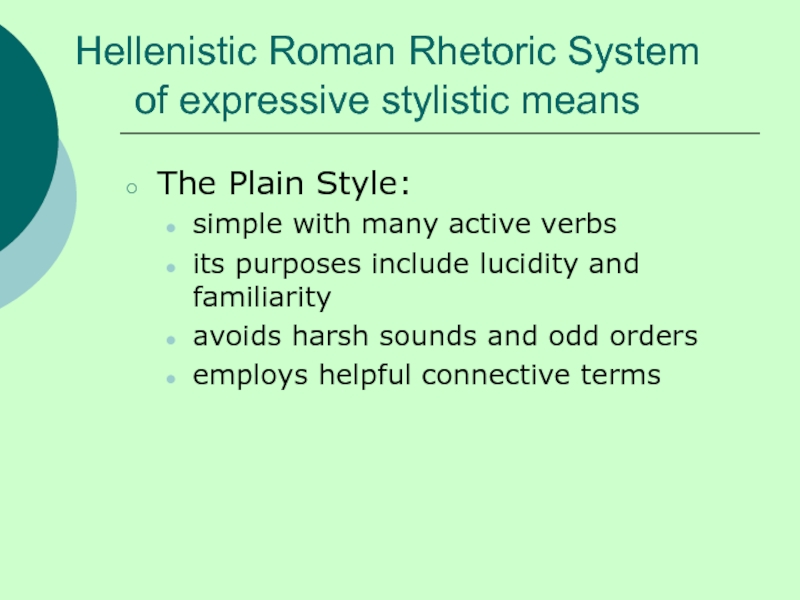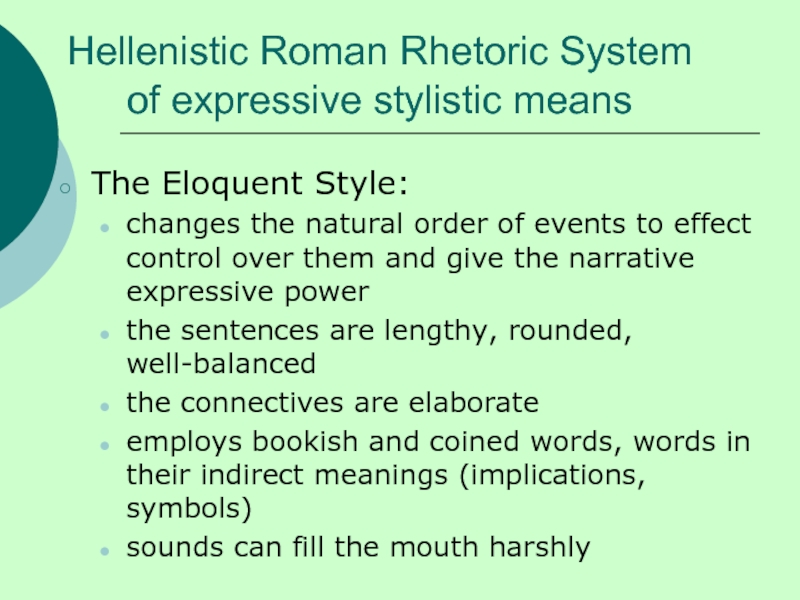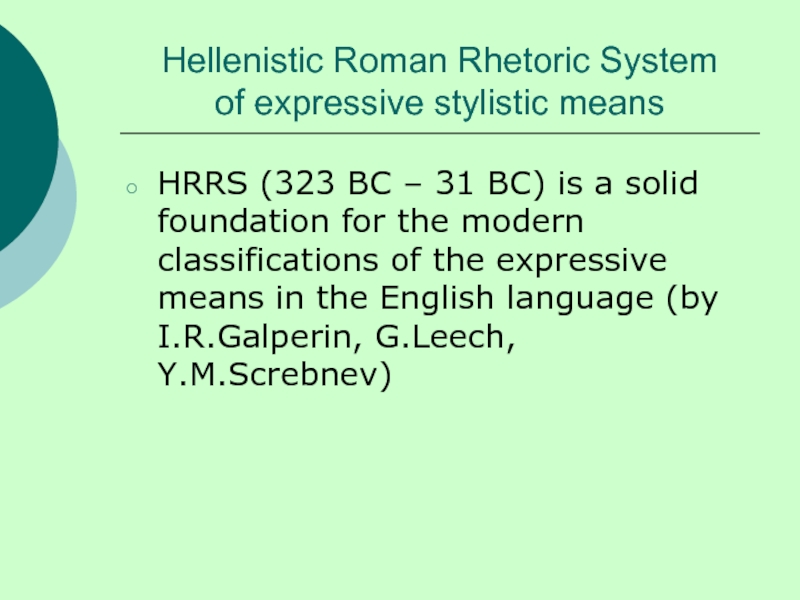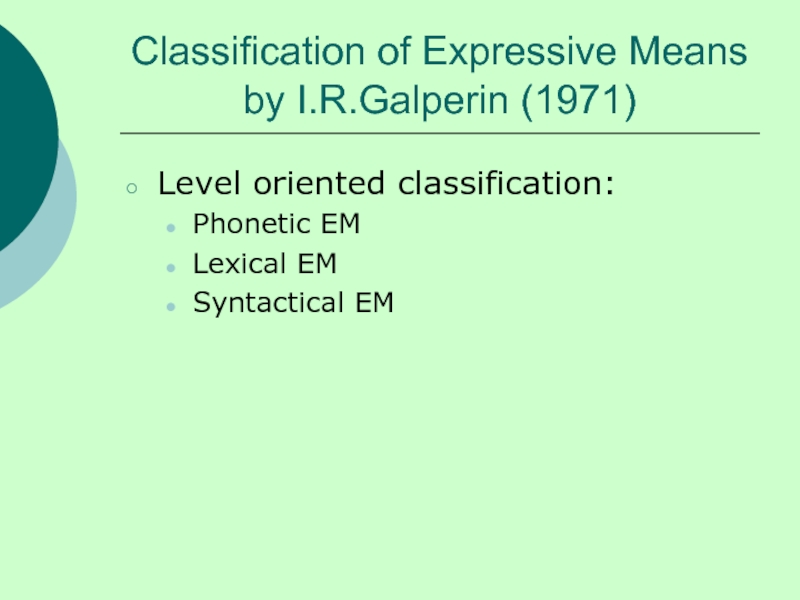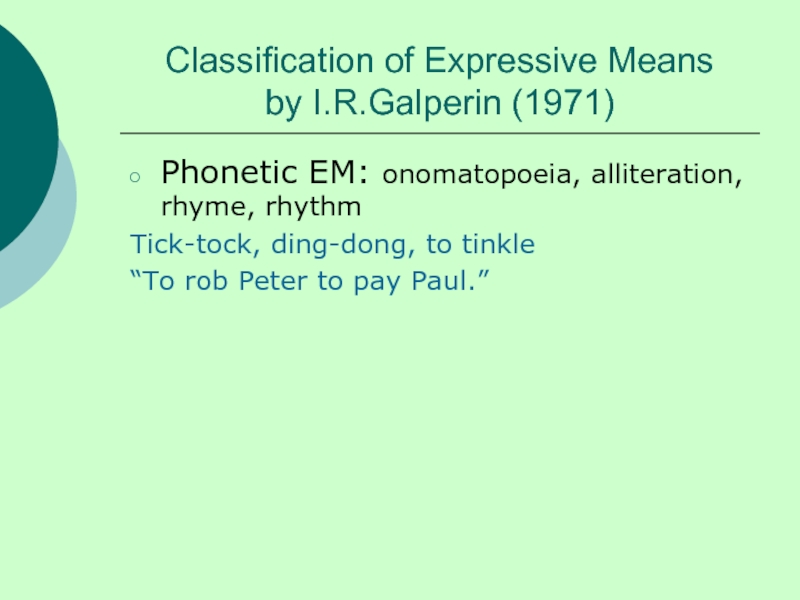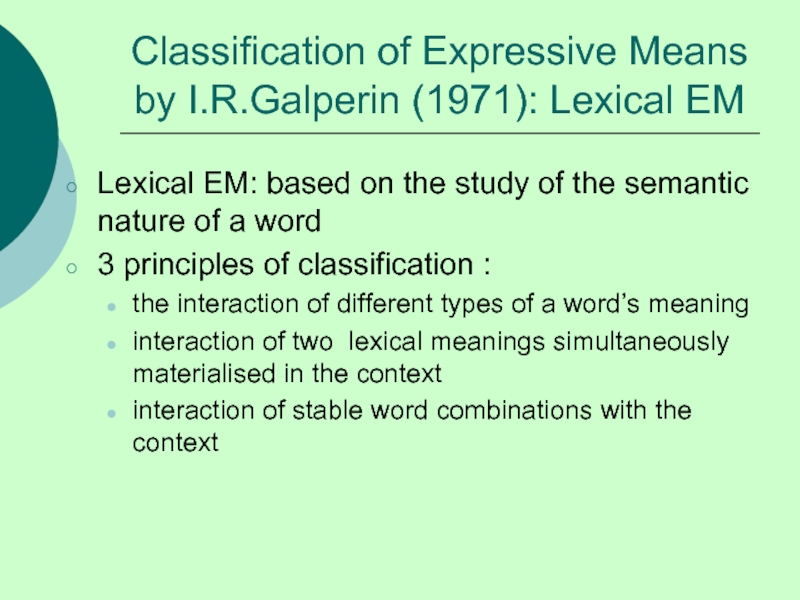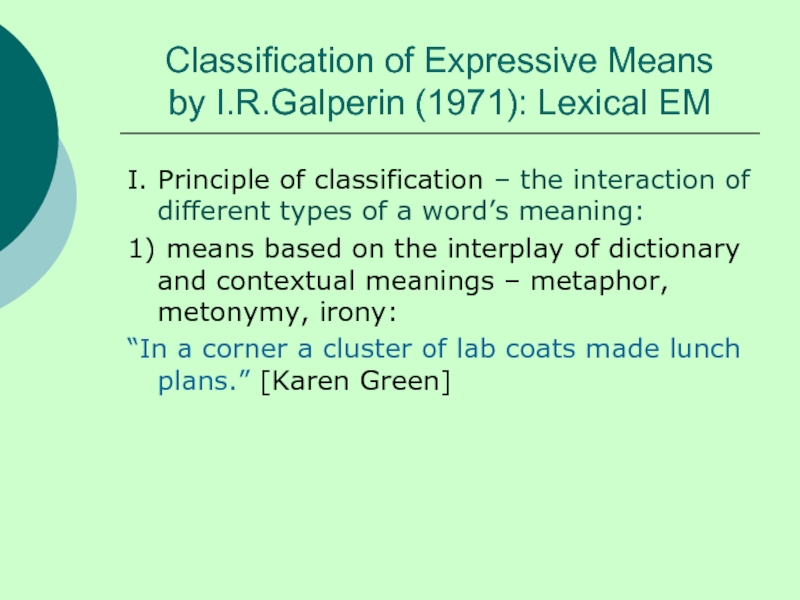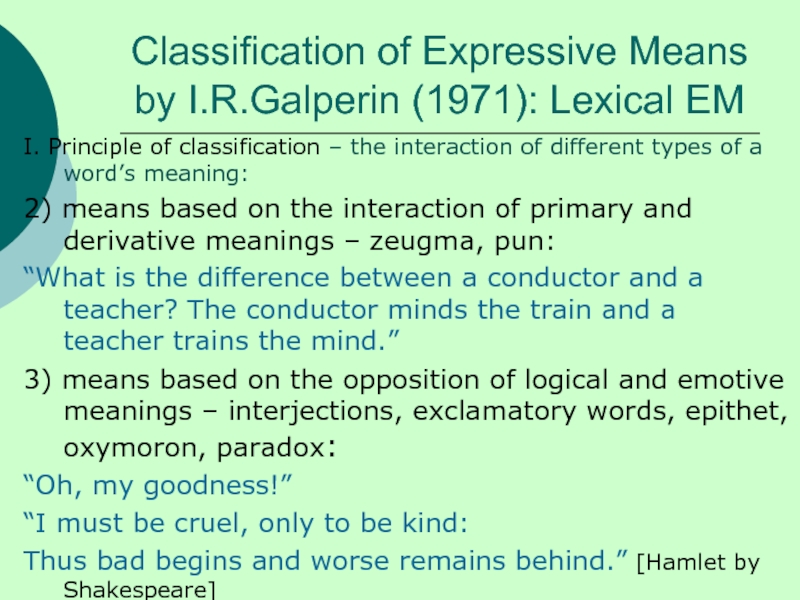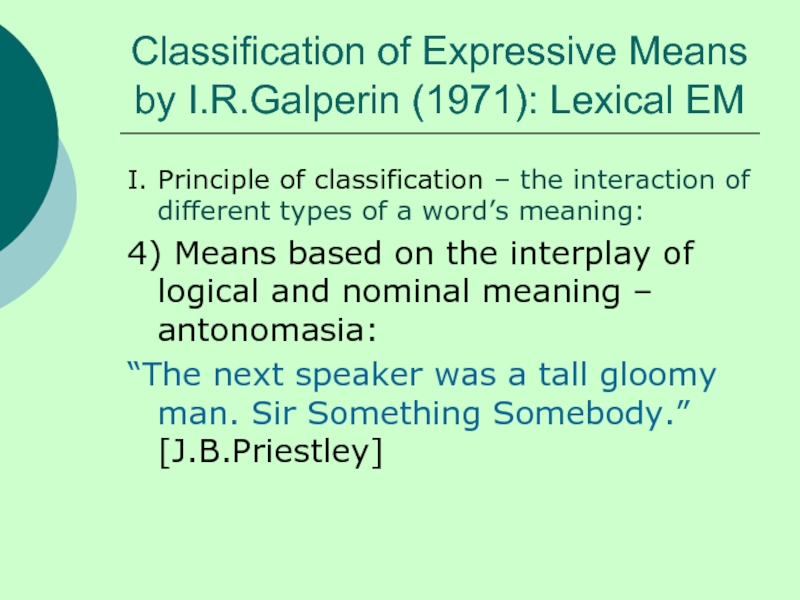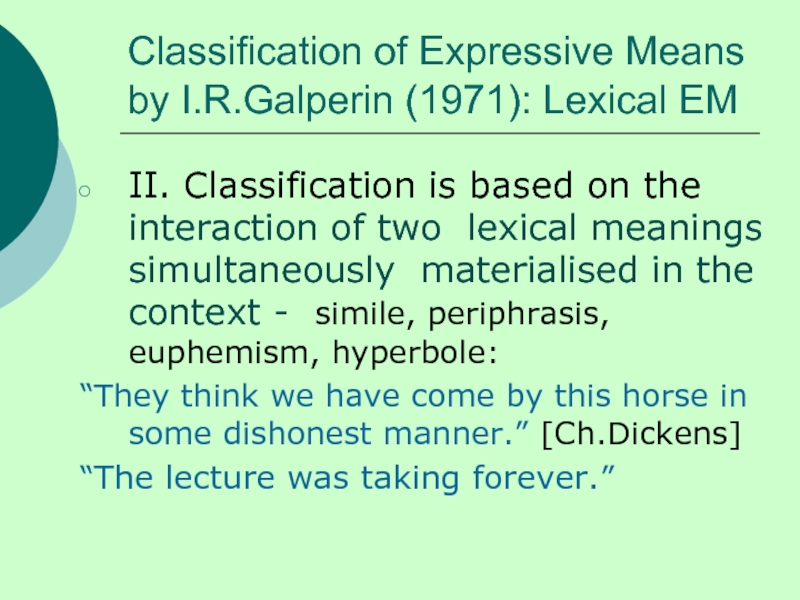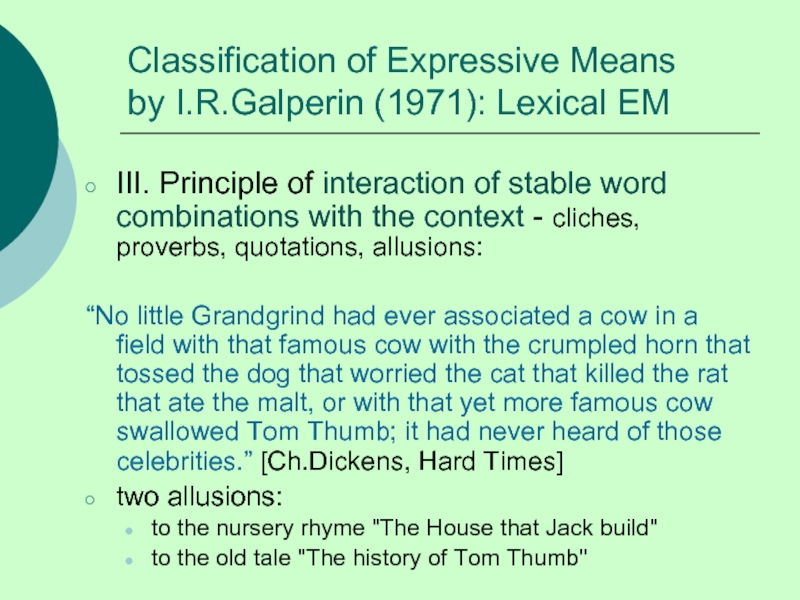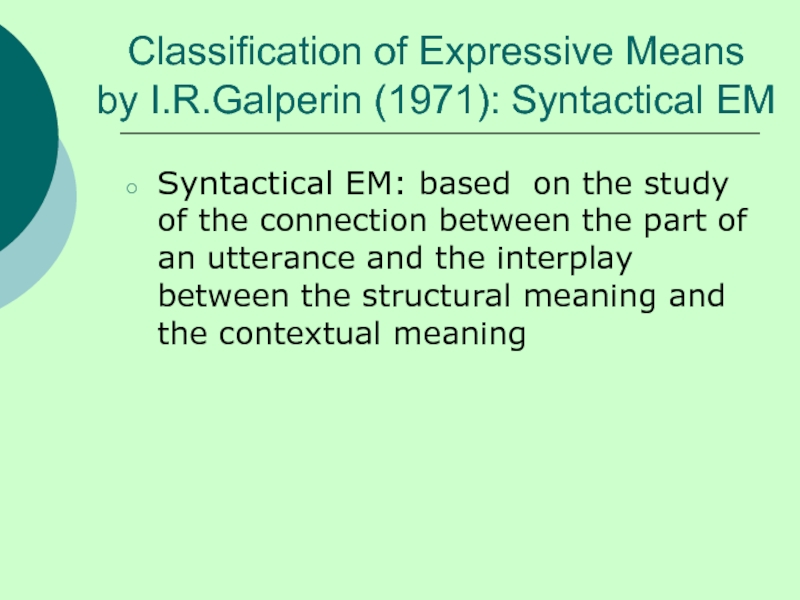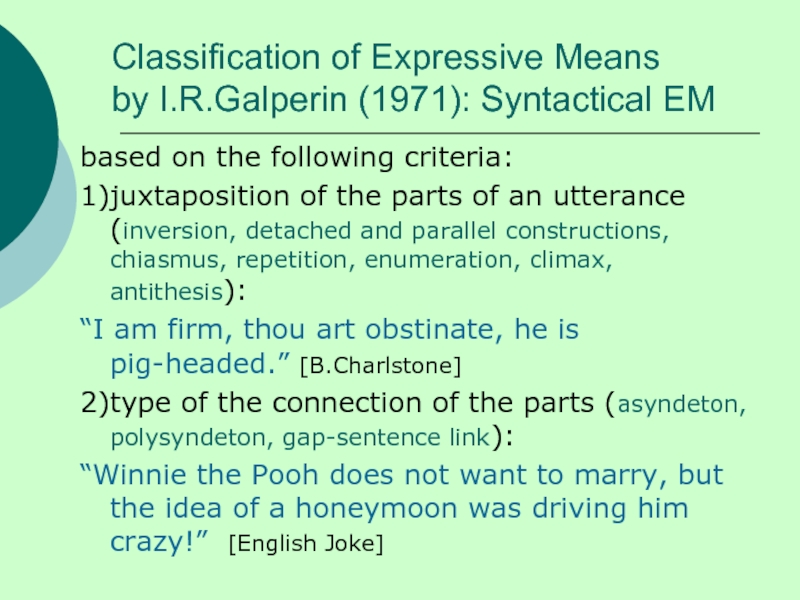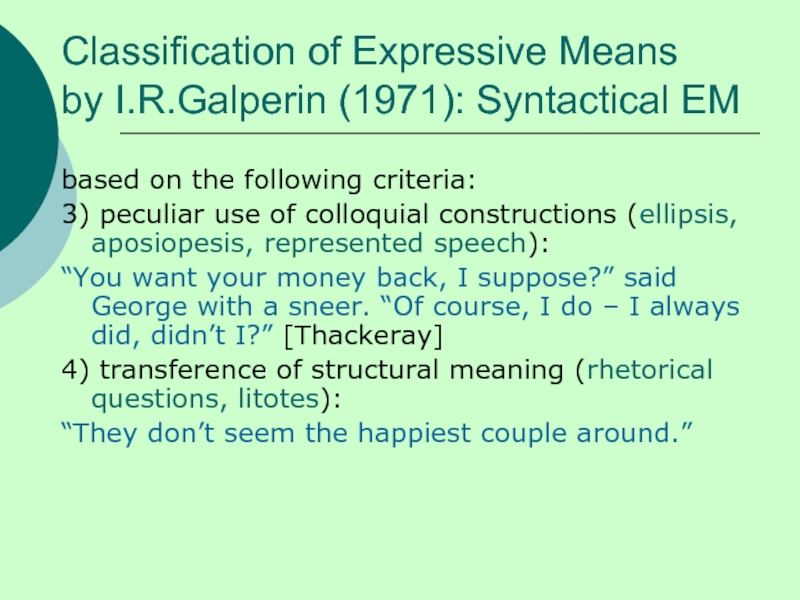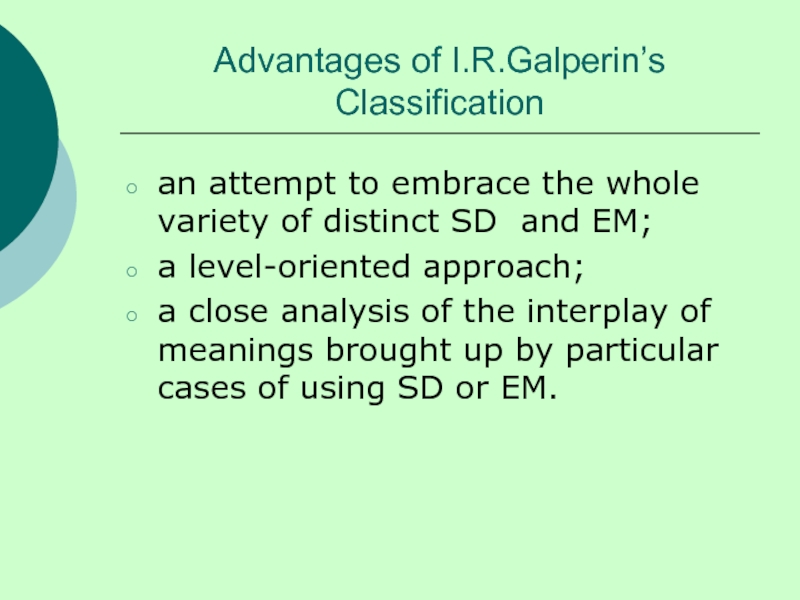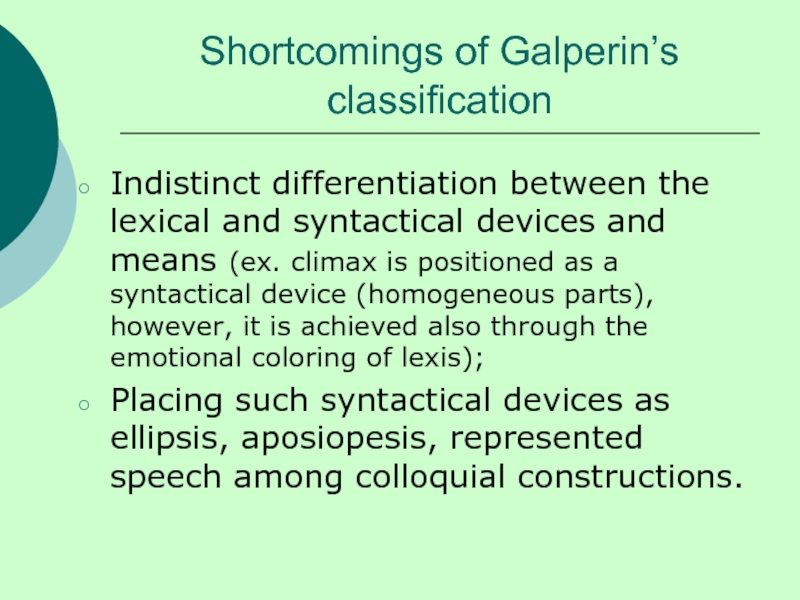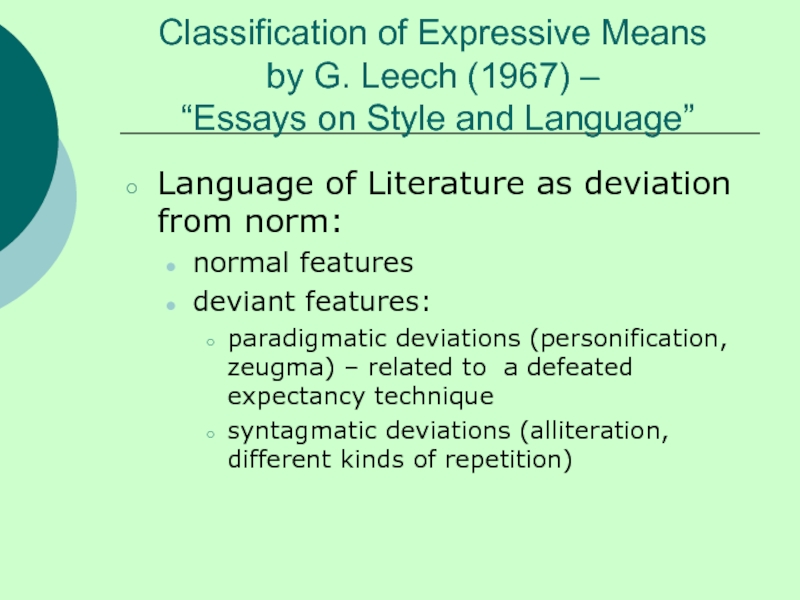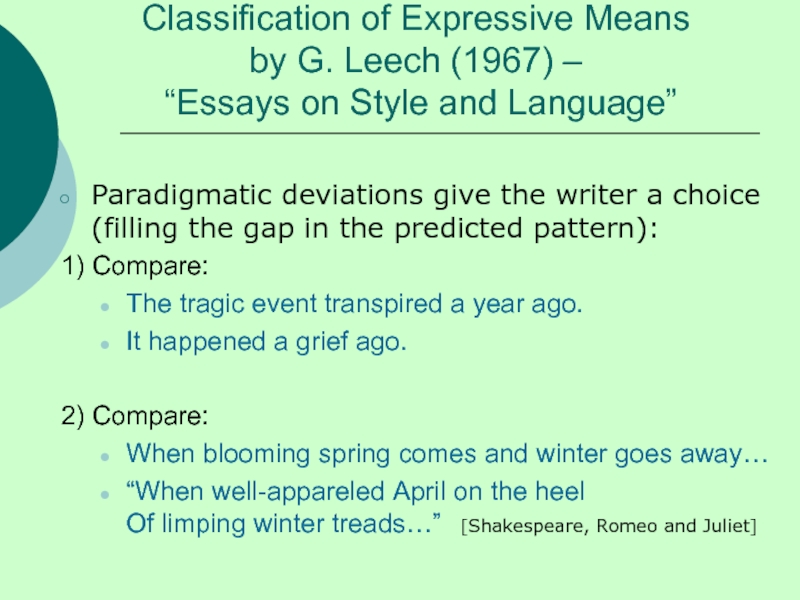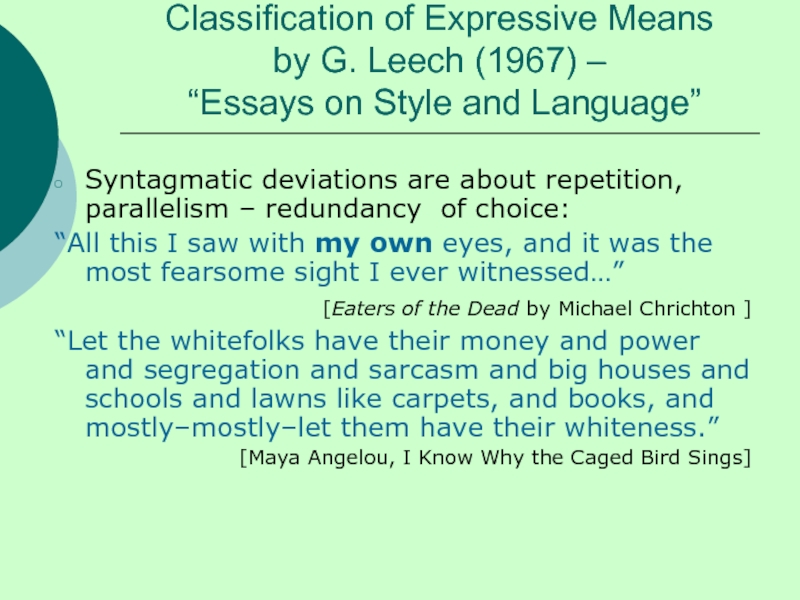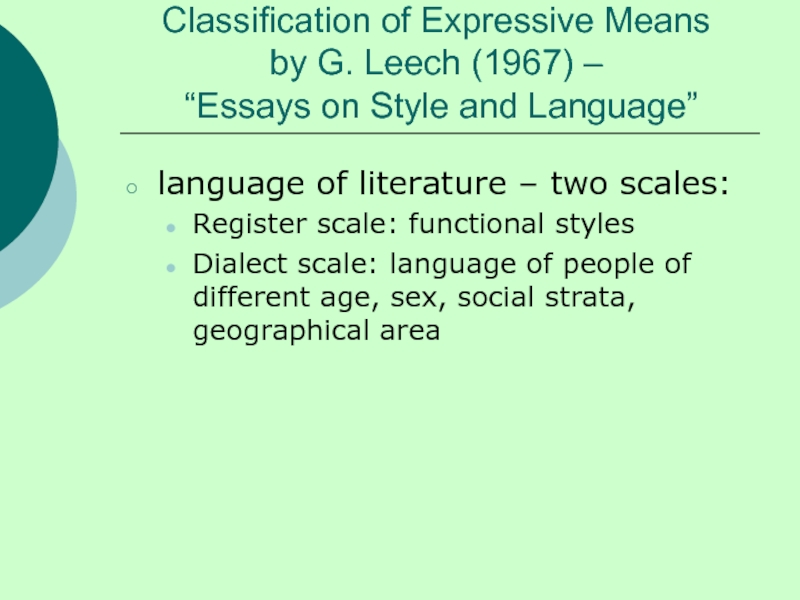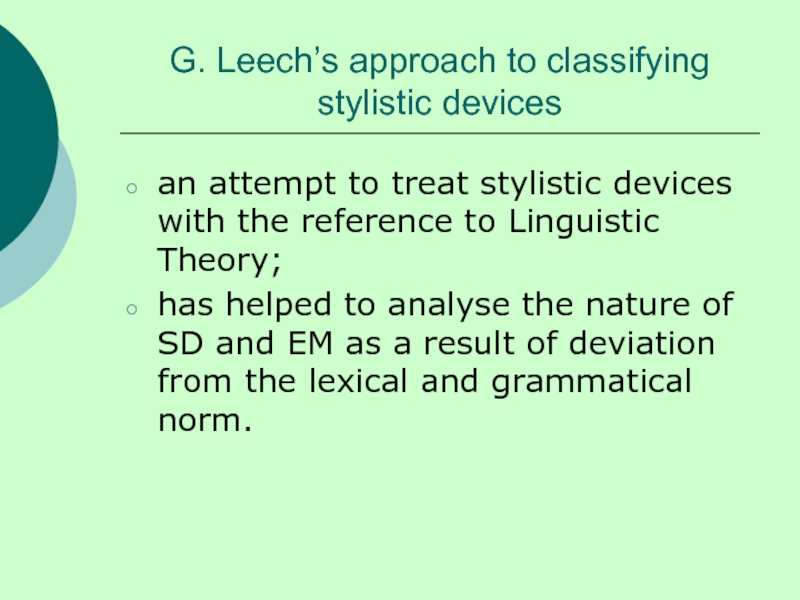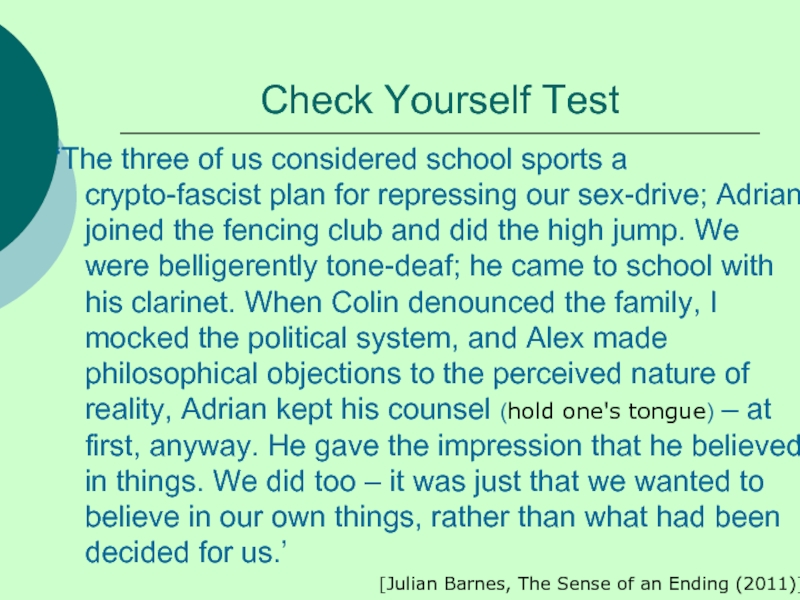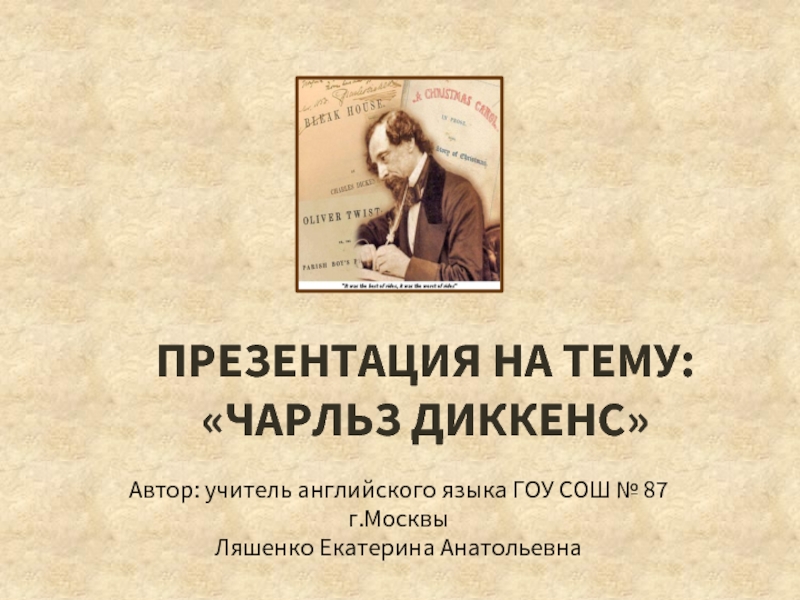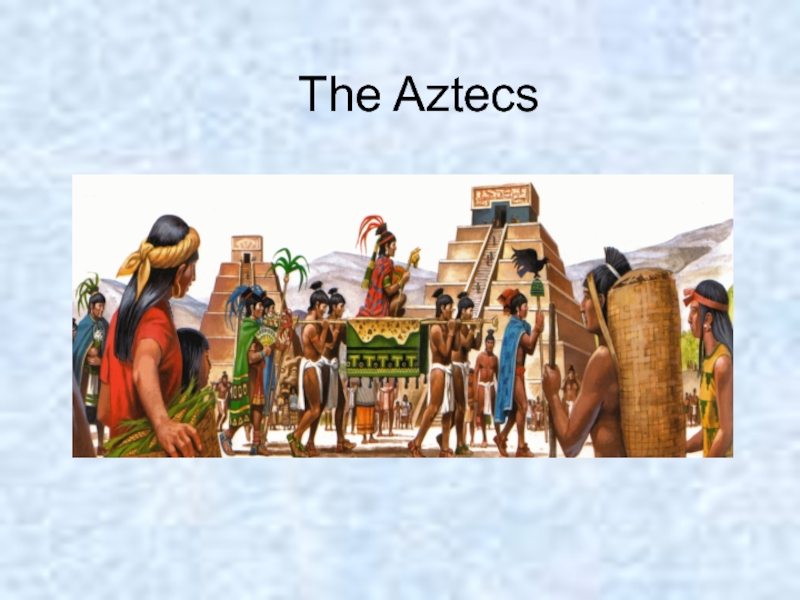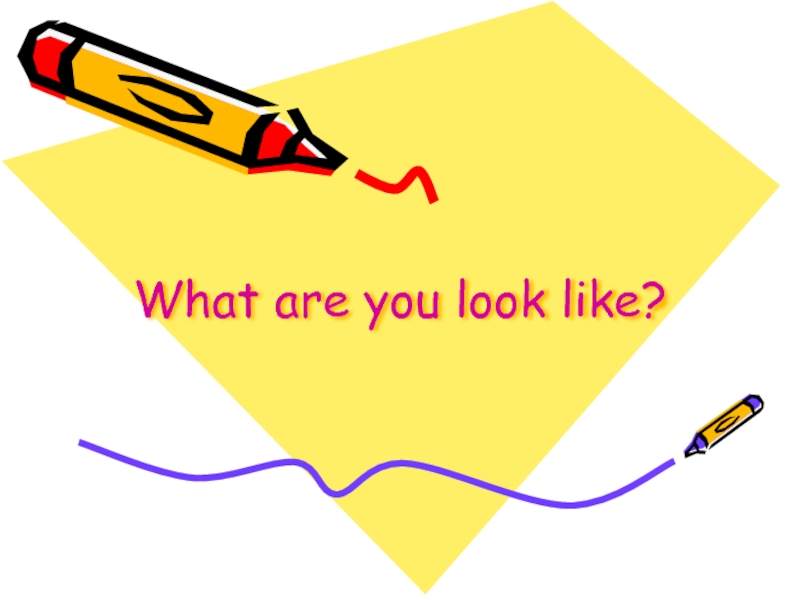- Главная
- Разное
- Дизайн
- Бизнес и предпринимательство
- Аналитика
- Образование
- Развлечения
- Красота и здоровье
- Финансы
- Государство
- Путешествия
- Спорт
- Недвижимость
- Армия
- Графика
- Культурология
- Еда и кулинария
- Лингвистика
- Английский язык
- Астрономия
- Алгебра
- Биология
- География
- Детские презентации
- Информатика
- История
- Литература
- Маркетинг
- Математика
- Медицина
- Менеджмент
- Музыка
- МХК
- Немецкий язык
- ОБЖ
- Обществознание
- Окружающий мир
- Педагогика
- Русский язык
- Технология
- Физика
- Философия
- Химия
- Шаблоны, картинки для презентаций
- Экология
- Экономика
- Юриспруденция
Stylistics of the English Language 12 презентация
Содержание
- 1. Stylistics of the English Language 12
- 2. Outline Classifications of Expressive Means: Aristotle
- 3. Aristotle and His Theory of Style
- 4. Aristotle and His Theory of Style Word
- 5. Aristotle and His Theory of Style Figures
- 6. Hellenistic Roman Rhetoric System of expressive stylistic
- 7. Hellenistic Roman Rhetoric System of expressive stylistic
- 8. Hellenistic Roman Rhetoric System of expressive stylistic
- 9. Hellenistic Roman Rhetoric System of expressive stylistic
- 10. Hellenistic Roman Rhetoric System of expressive stylistic
- 11. Hellenistic Roman Rhetoric System of expressive stylistic
- 12. Hellenistic Roman Rhetoric System of expressive stylistic
- 13. Hellenistic Roman Rhetoric System of expressive stylistic
- 14. Classification of Expressive Means by I.R.Galperin
- 15. Classification of Expressive Means by I.R.Galperin
- 16. Classification of Expressive Means by I.R.Galperin
- 17. Classification of Expressive Means by I.R.Galperin
- 18. Classification of Expressive Means by I.R.Galperin
- 19. Classification of Expressive Means by I.R.Galperin
- 20. Classification of Expressive Means by I.R.Galperin
- 21. Classification of Expressive Means by I.R.Galperin
- 22. Classification of Expressive Means by I.R.Galperin
- 23. Classification of Expressive Means by I.R.Galperin
- 24. Classification of Expressive Means by I.R.Galperin
- 25. Advantages of I.R.Galperin’s Classification an attempt to
- 26. Shortcomings of Galperin’s classification Indistinct differentiation between
- 27. Classification of Expressive Means by G.
- 28. Classification of Expressive Means by G.
- 29. Classification of Expressive Means by G.
- 30. Classification of Expressive Means by G.
- 31. G. Leech’s approach to classifying stylistic devices
- 32. Check Yourself Test ‘The three of us
- 33. Thank you for your attention ??
Слайд 1Stylistics of the English Language 12
Koroteeva
Valentina Vladimirovna,
valentina.shilova77@gmail.com
Слайд 2Outline
Classifications of Expressive Means:
Aristotle and His Theory of Style
Hellenistic Roman Rhetoric
Classification of Expressive Means by I.R.Galperin (1971)
Classification of Expressive Means by G. Leech (1967)
Слайд 3Aristotle and His Theory of Style
Language: literary and colloquial
Theory of Style:
The
Word combinations
Figures
Слайд 4Aristotle and His Theory of Style
Word combinations involved 3 things:
Order of
Word combinations
Rhythm and period (in rhetoric – a complete sentence)
Слайд 5Aristotle and His Theory of Style
Figures of Speech included 3 devices
antithesis
assonance of colons
equality of colons
***colon – one of the sections of a rhythmical period in Greek chorus consisting of a sequence of 2 to 6 feet
Слайд 6Hellenistic Roman Rhetoric System
of expressive stylistic means
Expressive stylistic means:
Tropes
Rhythm (Schemes /
Types of Speech
Слайд 7Hellenistic Roman Rhetoric System
of expressive stylistic means
1. Tropes: metaphor, riddle, synecdoche,
A fleet of fifty sail
A mighty fortress is our God.
The Iron Lady
What is so delicate that saying its name breaks it?
Have you got an alibi for being absent?
A thousand apologies.
Слайд 8Hellenistic Roman Rhetoric System
of expressive stylistic means
2. Rhythm (Schemes/Figures of Speech):
based
addition (doubling of words and sounds, polysyndeton, asyndeton, anaphora):
A wishy-washy style of writing
They lived and laughed and loved and left.
With malice toward none; with charity for all; with firmness in the right,... [Lincoln]
compression (zeugma, chiasmus, ellipsis):
Wise men talk because they have something to say; fools, because they have to say something.
He went to the country, to the town went she.
Eggs and oaths are soon broken.
Слайд 9Hellenistic Roman Rhetoric System
of expressive stylistic means
2. Rhythm (Schemes/Figures of Speech):
based on
assonance (equality of colons)
opposition (antithesis, inversion):
Me he restored, him he hanged.
To me alone there came a thought of grief. [William Wordsworth]
Слайд 10Hellenistic Roman Rhetoric System
of expressive stylistic means
3. Types of Speech: the
practical and aesthetic purposes
types: elevated, flowery, exquisite, poetic, normal, dry, scanty, hackneyed, tasteless
Слайд 11Hellenistic Roman Rhetoric System
of expressive stylistic means
The Plain Style:
simple with many
its purposes include lucidity and familiarity
avoids harsh sounds and odd orders
employs helpful connective terms
Слайд 12Hellenistic Roman Rhetoric System
of expressive stylistic means
The Eloquent Style:
changes the natural
the sentences are lengthy, rounded, well-balanced
the connectives are elaborate
employs bookish and coined words, words in their indirect meanings (implications, symbols)
sounds can fill the mouth harshly
Слайд 13Hellenistic Roman Rhetoric System
of expressive stylistic means
HRRS (323 BC – 31
Слайд 14Classification of Expressive Means
by I.R.Galperin (1971)
Level oriented classification:
Phonetic EM
Lexical EM
Syntactical
Слайд 15Classification of Expressive Means
by I.R.Galperin (1971)
Phonetic EM: onomatopoeia, alliteration, rhyme,
Tick-tock, ding-dong, to tinkle
“To rob Peter to pay Paul.”
Слайд 16Classification of Expressive Means
by I.R.Galperin (1971): Lexical EM
Lexical EM: based
3 principles of classification :
the interaction of different types of a word’s meaning
interaction of two lexical meanings simultaneously materialised in the context
interaction of stable word combinations with the context
Слайд 17Classification of Expressive Means
by I.R.Galperin (1971): Lexical EM
I. Principle of
1) means based on the interplay of dictionary and contextual meanings – metaphor, metonymy, irony:
“In a corner a cluster of lab coats made lunch plans.” [Karen Green]
Слайд 18Classification of Expressive Means
by I.R.Galperin (1971): Lexical EM
I. Principle of
2) means based on the interaction of primary and derivative meanings – zeugma, pun:
“What is the difference between a conductor and a teacher? The conductor minds the train and a teacher trains the mind.”
3) means based on the opposition of logical and emotive meanings – interjections, exclamatory words, epithet, oxymoron, paradox:
“Oh, my goodness!”
“I must be cruel, only to be kind:
Thus bad begins and worse remains behind.” [Hamlet by Shakespeare]
Слайд 19Classification of Expressive Means
by I.R.Galperin (1971): Lexical EM
I. Principle of
4) Means based on the interplay of logical and nominal meaning – antonomasia:
“The next speaker was a tall gloomy man. Sir Something Somebody.” [J.B.Priestley]
Слайд 20Classification of Expressive Means
by I.R.Galperin (1971): Lexical EM
II. Classification is
“They think we have come by this horse in some dishonest manner.” [Ch.Dickens]
“The lecture was taking forever.”
Слайд 21Classification of Expressive Means
by I.R.Galperin (1971): Lexical EM
III. Principle of
“No little Grandgrind had ever associated a cow in a field with that famous cow with the crumpled horn that tossed the dog that worried the cat that killed the rat that ate the malt, or with that yet more famous cow swallowed Tom Thumb; it had never heard of those celebrities.” [Ch.Dickens, Hard Times]
two allusions:
to the nursery rhyme "The House that Jack build"
to the old tale "The history of Tom Thumb"
Слайд 22Classification of Expressive Means
by I.R.Galperin (1971): Syntactical EM
Syntactical EM: based
Слайд 23Classification of Expressive Means
by I.R.Galperin (1971): Syntactical EM
based on the
1)juxtaposition of the parts of an utterance (inversion, detached and parallel constructions, chiasmus, repetition, enumeration, climax, antithesis):
“I am firm, thou art obstinate, he is pig-headed.” [B.Charlstone]
2)type of the connection of the parts (asyndeton, polysyndeton, gap-sentence link):
“Winnie the Pooh does not want to marry, but the idea of a honeymoon was driving him crazy!” [English Joke]
Слайд 24Classification of Expressive Means
by I.R.Galperin (1971): Syntactical EM
based on the
3) peculiar use of colloquial constructions (ellipsis, aposiopesis, represented speech):
“You want your money back, I suppose?” said George with a sneer. “Of course, I do – I always did, didn’t I?” [Thackeray]
4) transference of structural meaning (rhetorical questions, litotes):
“They don’t seem the happiest couple around.”
Слайд 25Advantages of I.R.Galperin’s Classification
an attempt to embrace the whole variety of
a level-oriented approach;
a close analysis of the interplay of meanings brought up by particular cases of using SD or EM.
Слайд 26Shortcomings of Galperin’s classification
Indistinct differentiation between the lexical and syntactical devices
Placing such syntactical devices as ellipsis, aposiopesis, represented speech among colloquial constructions.
Слайд 27Classification of Expressive Means by G. Leech (1967) – “Essays on
Language of Literature as deviation from norm:
normal features
deviant features:
paradigmatic deviations (personification, zeugma) – related to a defeated expectancy technique
syntagmatic deviations (alliteration, different kinds of repetition)
Слайд 28Classification of Expressive Means by G. Leech (1967) – “Essays on
Paradigmatic deviations give the writer a choice (filling the gap in the predicted pattern):
1) Compare:
The tragic event transpired a year ago.
It happened a grief ago.
2) Compare:
When blooming spring comes and winter goes away…
“When well-appareled April on the heel
Of limping winter treads…” [Shakespeare, Romeo and Juliet]
Слайд 29Classification of Expressive Means by G. Leech (1967) – “Essays on
Syntagmatic deviations are about repetition, parallelism – redundancy of choice:
“All this I saw with my own eyes, and it was the most fearsome sight I ever witnessed…”
[Eaters of the Dead by Michael Chrichton ]
“Let the whitefolks have their money and power and segregation and sarcasm and big houses and schools and lawns like carpets, and books, and mostly–mostly–let them have their whiteness.”
[Maya Angelou, I Know Why the Caged Bird Sings]
Слайд 30Classification of Expressive Means by G. Leech (1967) – “Essays on
language of literature – two scales:
Register scale: functional styles
Dialect scale: language of people of different age, sex, social strata, geographical area
Слайд 31G. Leech’s approach to classifying stylistic devices
an attempt to treat stylistic
has helped to analyse the nature of SD and EM as a result of deviation from the lexical and grammatical norm.
Слайд 32Check Yourself Test
‘The three of us considered school sports a crypto-fascist
[Julian Barnes, The Sense of an Ending (2011)]


